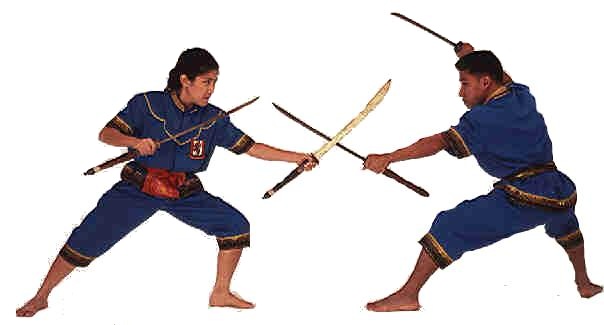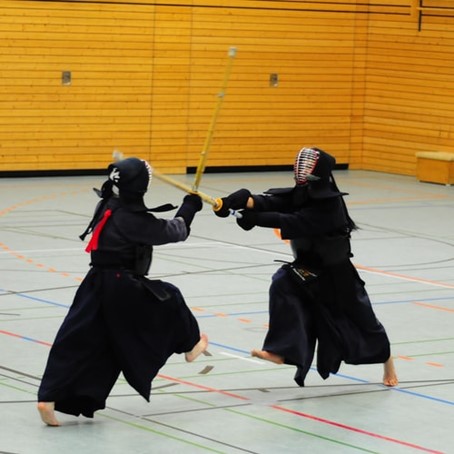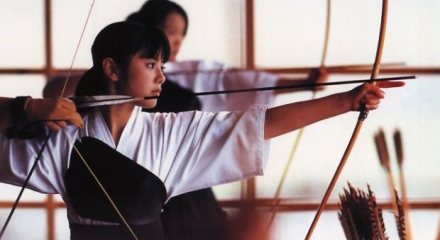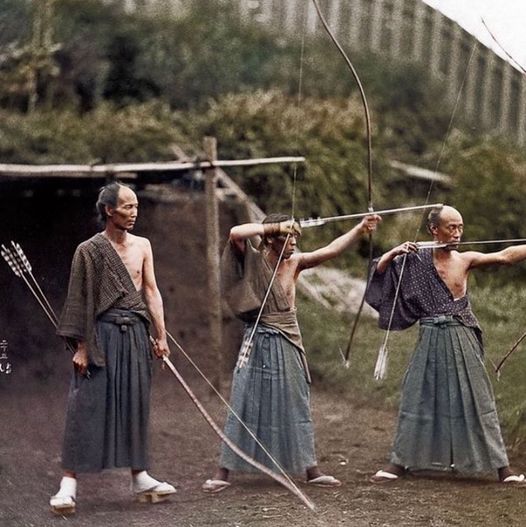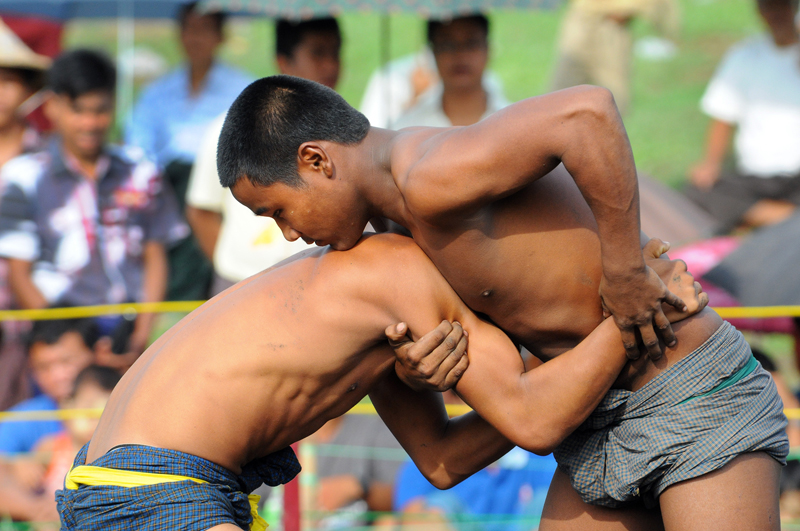- Name of sport (game): Kouchti
- Place of practice (continent, state, nation):
Pakistan
- Name of sport (game): Krabi krabong
- Name in native language: กระบี่กระบอง (Thai)
- Place of practice (continent, state, nation):
The sport is being practised mainly within the territory of Thailand, although it also happens to appear outside of its native region.
- History:
The techniques of Krabi krabong have already been developed in antiquity by drawing from a variety of different sports. The way of getting around with the staff is almost identical to the one used in Chinese monkey style, while rotating a one-handed weapon together with walking around a circle came from the Indian kalaripayattu. However these are not the only sources of inspiration. It is clearly visible that a solid part of the sport has been developed under the influence of Indonesian Silat or Burmese Banshay.
Additionally, most likely in XVII century, the Thai adapted the sword fighting techniques. That is when the Ronin troop supported them in quelling the riot caused by death of one of the kings.
In 1767, Thailand (at that time called Siam) has been attacked by the Burmese, having their capital city Ayutthaya destroyed. It resulted in majority of the chronicles and other sources being destroyed, hence the limited knowledge of the development of Krabi krabong among other things. The techniques, however, were being passed orally, which allowed the tradition to remain intact.
There were a lot of temple schools run by Buddhist monks across the country where Krabi krabong originated. Principles of Buddhism were taught there, as well as a variety of common subjects, such as astrology. What is more, young men were introduced to secrets of sword fighting identified with Krabi krabong.
The sport has been used for fighting until the coronation of King Rama II (1809) who reorganized the army and equipped it with muskets. Nevertheless, the sport has not only remained, but also became a part of contemporary tradition of Thailand.
Interestingly, the very name of the sport was established in 1936, when Krabi krabong has been added to the curriculum of the local Academy of Physical Education.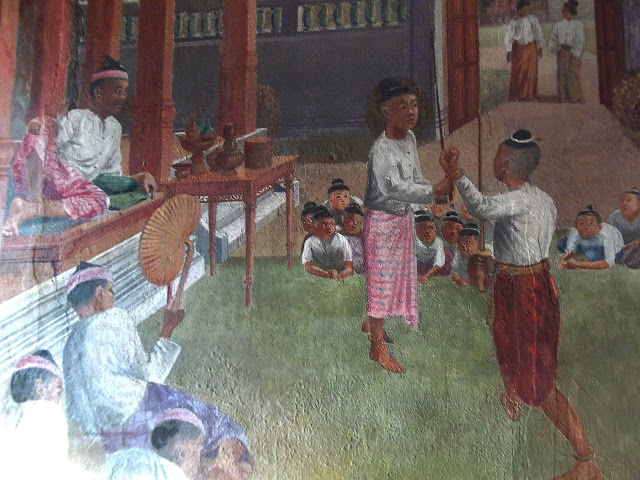
Mural painting - Naresuan's krabi-krabong (right with) Mingyi Swa.
- Description:
The duels are between two people inside the circle and are not limited in time. At the beginning, each participant acknowledges their mentor and takes part in a ritual dance to commemorate the old masters and honour the Gods who are believed to give them strength in return. The weapons used in the ritual were heavily ornamented and did not take part in the actual fight. What is more, the fight is usually accompanied by Thai music.
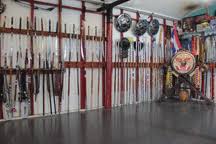
During the fight, participants use the following weapons:
1) Krabi – thin and sharp sword, reminiscent of saber; used for stabbing.
2) Krabong – 1,8 meter long straight staff, made of ebony or teak.
3) Na mai – small crossbow, used for fighting from a distance.
4) Kaen – rectangular shield covering the arm; can be used for attacking with the sharpened edge.
5) Daeng – longitudinal shield made of metal or leather, covers part of the body from arms to knees.
6) Lob – round shield made of wood, leather or metal; the shield is so big that it can cover the whole body; it also has sharpened edge, which can be used for attacking.
7) Daab – Sword heavier than krabi with a lot more sharpened blade, its handle is made of wood or bone; used for cutting or stabbing.
8) Ngao – Bladed staff, often used by the royal family; the blade could take shape of a knife, trident or even sword; used for stabbing, cutting or disarming the opponent.
9) Mae Sowk – two clubs made from teak or bone, with handles on the one side, and rope on the other, which allow participants to hold it on their forearms; used mainly for defence.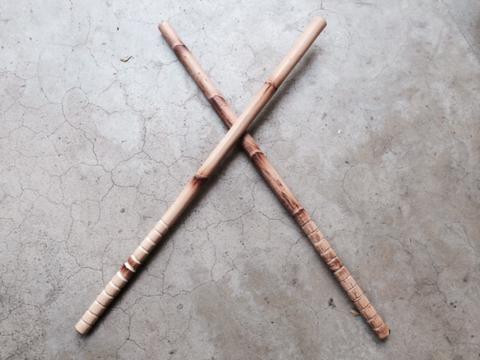
However the most commonly used weapons are two daab swords. Interestingly, participants are able to fight unarmed, using kicks, grips, throws or even hit the vulnerable spots. The loose of one sword, forces the participant into the unfair fight against the opponent with two swords.
The winner is decided on the basis of the skills and endurance of the participants and the fight ends upon declaring a winner. Wounds or injuries do not result in defeat.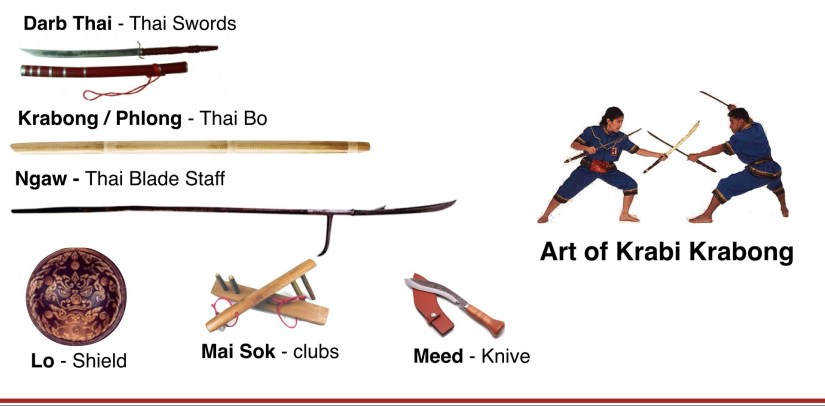
- Current status:
Krabi krabong is still being practised today. On account of becoming a part of the Thai tradition, the fights are held during a variety of festivals or events across the country. Even though the police and army of Thailand are introduced to the Krabi krabong fighting style, very few schools include this sport in their curriculum. The most popular one is certainly Buddhai Swan Sword Fighting Institute in Nongkaem. It has been functioning for over 400 years, teaching the Thai as well as the foreign.
Krabi krabong is also taught in Sritairat located in Dhonburi suburbs, Muay Thai Sangha or Tiger Muay Thai. What is more, Germany also hosts a school that includes Krabi krabong in its curriculum, which is located in Dülmen, near Münster. England is also known to host such school.
These days, Krabi krabong is being supported by muay thai as well as muay boran. All three originated in Thailand and were inspiring each other, hence a lot of techniques used in one discipline appears in the other. The reasons for the diminishing popularity of Krabi krabong are unknown, but it is believed that it was caused by the multitude of weapons used and the lack of tournaments being held. - Contacts:
Sitsiam Camp
http://sitsiam-camp.com
+44 7903 105561This email address is being protected from spambots. You need JavaScript enabled to view it.
Portland Mill, Brook Street Ease, Unit 1, 3rd Floor, Ashton-under-Lyne, OL6 7SXThaiAchira, school in Germany:
http://www.thaiachira.de/
+49 176 50197067This email address is being protected from spambots. You need JavaScript enabled to view it.
Max Planck Str 8, 48249 Duelmen-BuldernTiger Muay Thai, school in Thailand:
https://www.tigermuaythai.com
+66 76 367 071This email address is being protected from spambots. You need JavaScript enabled to view it.
7/35 Moo 5, Soi Ta-iedBuddhai Sawan Krabi-Krabong Association of The United States - http://www.vitaliccombatarts.com/krabikrabong/
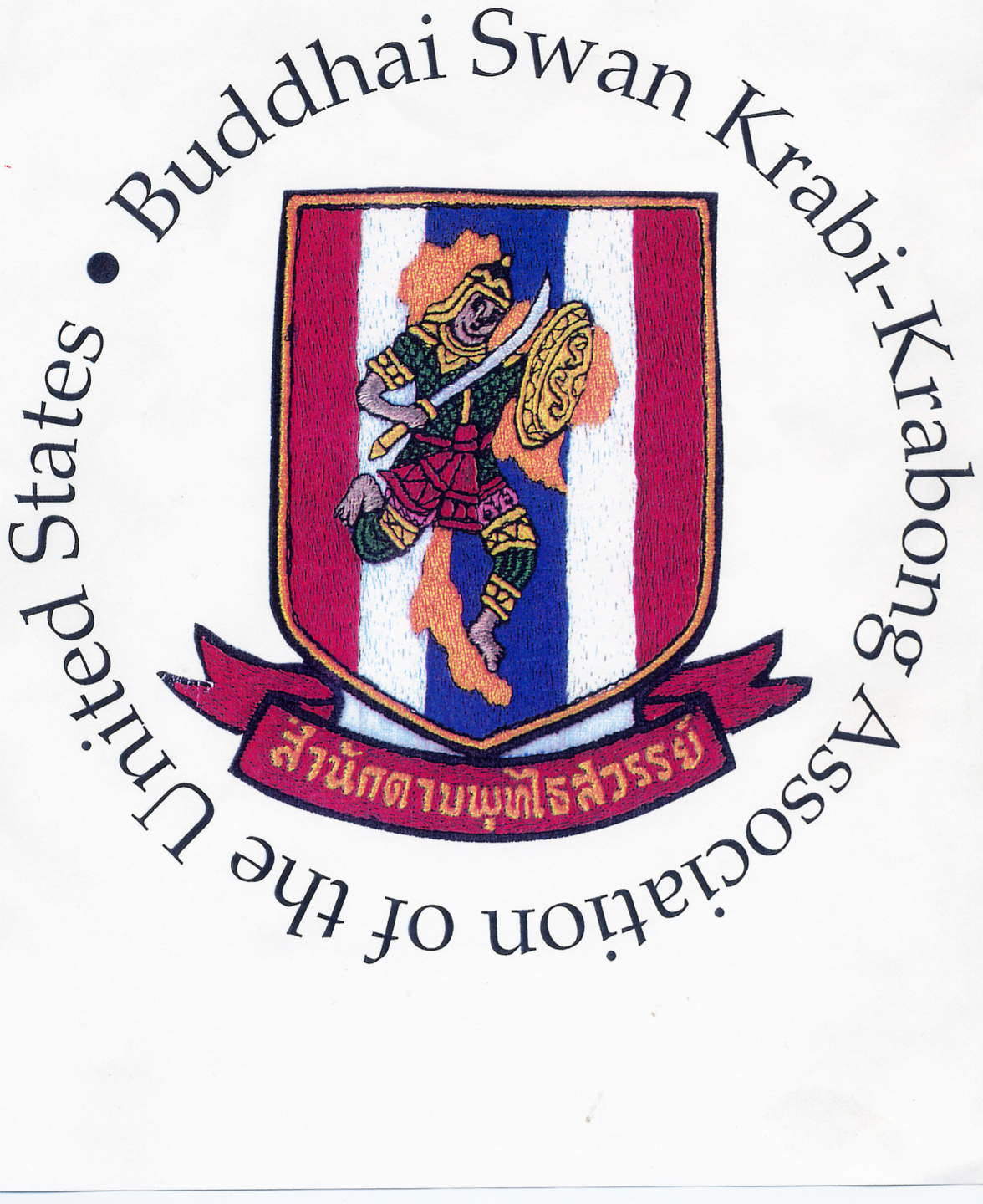
- Sources of information :
Łukasz Ławniczak, Historyczne podstawy i ewolucja tajskich sztuk walki – muay thai i krabi-krabong (do XX w.), Gdańskie Studia Azji Wschodniej [Online], Zeszyt 3 (2013): 140-152, http://www.ejournals.eu/GSAW/2013/Zeszyt-3-2013/art/2622/ ;
Simon La Loubère, The Kingdom of Siam, Oxford University Press, 1986;
Robert Crego, Sports and Games of the 18th and 19th Centuries pg 32. Greenwood Press, 2003;
Donn F. Draeger and Robert W. Smith (1981). Comprehensive Asian Fighting Arts. Kodansha International;
Por Kru Samai Mesamarn, Krabi Krabong: The Buddhai Sawan Path, DVD 2010;
Ajarn Foong Keodkeau, The Untold History of Krabi Karbong, 1984 (available: https://pahuyuth.com/en/daab/the-untold-history-of-krabi-krabong/);
Pedro Solana Villalobos, Krabi-Krabong: Thailand's Art of Weapons Fighting, Paladin Press, 2007;
Frederic P. Miller, Agnes F. Vandome, McBrewster John, Krabi Krabong, VDM Publishing, 2010;Krabi-krabong: https://www.awakeningfighters.com/awakepedia/krabi-krabong/
Krabi-krabong: http://warriors-journey.com/en/krabi-krabong/
Krabi-krabong: http://thai-martial-arts.blogspot.com/2017/09/traditional-thai-martialarts.html
Krabi-krabong: http://www.aitma.de/aitma_krabikrabong.htmSource of photos used in this article and gallery:
https://theblindninja.tumblr.com/post/179235629592/krabi-krabong-thai-style-dual-sword-fighting - Gallery:
- Documents:
 Lawniczak_-_Historyczne_podstawy_i_ewolucja_tajskich_sztuk_walki_Muay_Thai_i_Krabi-Krabong.pdf
Lawniczak_-_Historyczne_podstawy_i_ewolucja_tajskich_sztuk_walki_Muay_Thai_i_Krabi-Krabong.pdf
- Name of sport (game): Kumdo
- Place of practice (continent, state, nation):
Korea
- History:
Kumdo (Gumdo) means “the way of the sword”.
Kendo is Japanese fencing whereas Kumdo is Korean fencing. They differ in that Kendo is more strategic as practitioners seek the “perfect strike.” Kumdo, on the other hand, is more aggressive in nature, as practitioners proactively draw out their opponents.
Kumdo is Korean. But it’s derived from Kendo, a Japanese martial art form. In the late 1800s, Kendo was introduced to Korea by the Japanese as one of the ways to train the police. But in time, it morphed into Kumdo, a Korean art form with a distinctive flavor that makes it different from its ancestor.In the fourth century of the Common Era a new system of metallurgy was introduced to the Korea Peninsula from China. This introduction gave birth to a new and superior weaponry. Previously, the bow and the staff had been the primary tools of warfare. With the introduction of refined metal crafting, the sword took on new importance. This was because of the fact that this new metallurgy made the sword a much more reliable weapon, as it became more difficult to fracture during battle.
At this juncture of history, Korea was divided into three warring kingdoms: Koguryo, Silla, and Paekche. Due to this fact, beginning in the fifth century C.E., formalized groups of warriors came into existence on the Korean Peninsula. These warriors embraced Buddhism and devoted themselves to the cultivation of moral values, based in Confucian ideology. These warriors took martial warfare to a new and much more refined level of understanding than had been previously embraced. Among these armies were the Kyong Dang of Koguryo and, most notably, the Hwa Rang of Silla.
The Hwa Rang were formed during the reign of King Chin Heung. They were an elite, warrior corps, made up of young noblemen. These warriors trained their bodies and minds in all forms of martial understanding. The Hwa Rang, through refined military strategy, defeated their neighboring armies and unified the three Korean kingdoms. Throughout history, Korea has looked to the Hwa Rang for inspiration for the martial art tradition.
As the sword became the key instrument of close contact warfare, it was one of the Hwa Rang's primary weapons. The techniques of the Korean sword, at this period of time, were stylistically formalized into twenty-five poses and postures that would most rapidly result in an opponent's demise.The Philosophy of Kum Do: “Kal-deung is the sky and Kal-nal is the land, therefore Kal itself produces the combination of Um and Yang (Yin and Yang). Son-jap-yi is a king and Kal is the subject to the king’s will. Abusing Kal could cost one’s life, therefore, there should be Do (Way) when handling Kal (Sword).
That is Kum Do.” Kum Do is traditional Korean swordsmanship, which is more than a sport. It is a form of art that is considered both a discipline as well as a sport. Kum Do is both physical and psychological training. First of all, with Kum (sword), one can practice to improve one’s physical fitness, by practicing various attacks, blocks and forms. Do (the Way) helps control one’s mind and inner desire. All Kum Do activities help growth of muscle, bone and enhance vital energy. Kum Do is a way to defend oneself with physical improvement and regulation of one’s health and longevity.
Throughout Korean history, various swords techniques were practiced by both men and women. At one time in Korea, women were allowed to practice only with a palm-sized knife, Eun-jang-do, for self-defense. Today, however, Kum Do is practiced by men, women, and children of all ages and abilities. Kum Do practice at Kang’s Martial Arts emphasizes discipline, mental and physical skill as well as health and conditioning.
Kum Do forms is like a sword dance, which is based off ancient Korean traditions. Forms are essential to teaching proper technique, body posture, and balance. Kum Do sparring gives the student a chance to apply sword technique in actual combat situations in a safe way. Bamboo swords are used to strike targets and in sparring matches where armor is worn to prevent injury.
- Description:
"Kumdo," literally means, "Sword Way." Kumdo is a Korean translation of the Japanese term, "Kendo." "Ken" meaning, "Sword," and, "Do" meaning, "Way."
The Korean art of Kumdo is a direct interpretation of its Japanese counterpart. In fact, some of the early founders of Kumdo claim that there is absolutely no difference between the two arts.The parallels between Korean Kumdo and Japanese Kendo can not be overlooked as one comes to define this art. Though Kumdo possesses its own cultural identity, the correlation between the two arts is very clear.
To begin to see the influence Kendo has had upon Kumdo, one need only look at the uniform. Most Kumdo schools wear the same clothing as their Japanese counterpart. The Kumdo practitioner wears the "Hakama," the large pleated pants. Kendo armor, known as, "Hoogo," in Korean is also commonly worn during competitions.
Hoogoo is made up of the, "Ho Myun," head and face protector. "Gap," which protects the chest. "Ho Wam," which protects the hands. "Gap Sang," which is the apron which protects the waist and groin.
The Kendo bamboo sword, known as, "Shinai," in Japanese and "Juk Do," in Korean, is a key element of partner practice in Kumdo. The wooden sword, "Bokken," in Japanese and "Mok Kum" in Korean, is also a common training tool.
The practitioner of Kendo uses a long samurai sword or "Katana" for these drawing and striking techniques. The Kumdo practitioner performs his techniques with a long steel sword known in Korean as, "Jung Kum."
The basic difference between the Japanese and the Korean long sword is that the katana possesses a slight arch. The jung kum, on the other hand, is oftentimes straight. The use of the jung kum is not universal in Kumdo, however, and the Japanese katana oftentimes replaces it.
The straight design of the jung kum was brought into utilization predominately by the modern Korean systems of Kuk Sul Won and Hwa Rang Do. Both of these systems possess a more Chinese influenced art of swordplay than does Kumdo. Though the straight sword is now commonly associated with the Korean arts, in the Moo Yeh Do Bok Tong Gi, the long swords are detailed as possessing the same arch as those used by the Japanese Samurai.
When one begins the practice of Kumdo, the primary focus is placed upon "Iwa Sae" or proper stance. It is understood that without a proper stance no sword technique can be performed efficiently. Therefore, extensive emphasis is placed on this element of Kumdo training.
The "Tanjun," more commonly known by the Japanese term, "Hara," is understood to be an individual's center of gravity. This bodily location exists approximately four inches below the navel.
In Kumdo, it is understood that all sword techniques must be launched with a consciousness placed on this bodily location or the practitioner will easily be set off balance by his sword. From a more metaphysical perspective the tanjun is also understood to be the location where ki, "Internal energy" congregates. Thus, this location is quite revered.
Human breath is known to be the link to ki. Thus, a Kumdo practitioner always breathes in ki and mentally directs it to his tanjun at the outset of each sword movement. When the sword is unleashed, this ki filled breath is released with a, "Kiap," a martial arts yell. This signals that ki is being expelled as the sword moves towards its target.In Kumdo, the sword is held with your lead hand placed just under the sword guard. In some designs the jung kum possesses no sword guard. In these cases, your lead is placed in the same location, at the upper region of the sword's handle. Your rear hand is located at the bottom of the sword's handle. From this grasp, maximum control is maintained over the sword.
In certain Kumdo techniques, the sword is wielded with one hand. In this case, the hand holding the sword remains close under the sword guard. Thus, maintaining maximum balance and control over the sword.
When the jung kum is held, your elbows should remain slightly bent. This is true in all Kumdo drawing, ready position, and striking techniques. From this, you allow your arms to remain loose. Thus, possessing the ability to readily direct or redirect your sword technique with speed and accuracy.
In Kumdo, as with Iaido, the primary focusing technique witnesses the practitioner precisely draw the sword and unleash a highly defined striking technique. In Kumdo, once the sword has been unsheathed, these defined strikes often times include the use of the sheath as a blocking tool. This use of the sheath, as a defensive weapon, is one of the factors, which separates Kumdo from most schools of Iaido.All techniques used in Kumdo are based in eight primary strikes:
1) Overhead Strike, Straight
2) Overhead Slash, Left Side
3) Overhead Slash, Right Side
4) Side Slash, from the left
5) Side Slash, from the right
6) Under Slash, from the left
7) Under Slash, from the right
8) Under Body StrikeVariations are added to these techniques as the Kumdo practitioner becomes more advanced with his use of the sword.
Sword Strikes
In Kumdo the strike of the sword is never over extended. The practitioner must always control the blade as opposed to being controlled by its weight and momentum. This is accomplished by never randomly striking at the imaginary targets. All strikes are performed consciously with precise impact points in mind.
The development of proper sword strike ability is achieved through conscious practice and proper technique. A sword, in practice, is always extended with the same intent or controlled force that would be used in a true confrontational situation. It is a misnomer that a sword is wielded with a different intensity when one is defending against an imaginary opponent or a real object.Kumdo sword strikes are made in linear fashion. That is to say, they are performed in a straight to the target pattern. Whenever a strike is performed with the sword, it is quickly and precisely snapped into its final position. The sword techniques are not ornamented or flashy. And, no unnecessary energy is used when they are performed. This is where Kumdo differs from some of the Chinese schools of swordplay.
As is the same with the kicking and punching techniques indigenous to Korea, all sword strikes are not ended at the beginning of the target. They are, instead, performed in an application that would penetrate and go through said target. This implementation does not negate the previously mentioned conscious impact point. What it does entail is that the Kumdo swordsmen learns how much impact must be delivered in each sword application to penetrate their intended target.
All Kumdo sword strikes are precisely implemented movements. Through continued practice the swordsman comes to the understand how each sword technique is most efficiently performed. This is accomplished by observing how much force is used in each sword technique, where that energy is most effectively focused, and how much power it will take to achieve the desired result. All of this come from continued practice and developed understanding.The practice and development of Kumdo relies heavily upon forms training. Forms are known by the Korean word, "Hyung." Specifically Kumdo forms are referred to as, "Bon Kuk Kum Bop."
There are ten primary forms that are used in Kumdo. With in these forms, the majority of all the sword techniques are used and then integrated with the various applicable foot and hand techniques.
In many schools of Kumdo, the techniques of the sword are integrated with the weaponless fighting styles of Korea. For example, kicks and to a lesser degree, hand strikes are incorporated into all methods of sword practice. This is particularly the case of the hyung of Kumdo.Kumdo Vocabulary
Juk do - bamboo sword
Jung Kum &endash; Long sword
Kal - sword or knife
Kal geut - tip of the blade
Kal jip - sheath
Kum - sword
Kumdo - way of the sword
Kum sool - term for sword skills
Mok kum - wooden practice swordSource: Scott Shaw, Just How Korean is Korea's Way of the Sword, Black Belt Magazine, May 2000
Equipment - common types of equipment used in Kumdo include the following:
Myŏn-soo-goon -- a lightweight scarf, typically mad of cotton, that's worn under the helmet for protection.
Homyeoum -- wire-mesh helmet that's worn to protect the face.
Kap -- a protective vest worn over the torso.
Kapsang -- type of canvas and leather skirt worn to protect the lower body.
Howan -- protective mitts with side cuffs.
Ko-dûng-i -- the hilt of a sword, used to protect the hands.
Duengjul -- yellow-colored string attached to the sword's tip and guard.
Joonghyuk -- leather band that marks the "striking" area of the sword.
Sunnhyuk -- leather cap, representing the tip of the sword.
Byounghyuk -- Handle of the sword.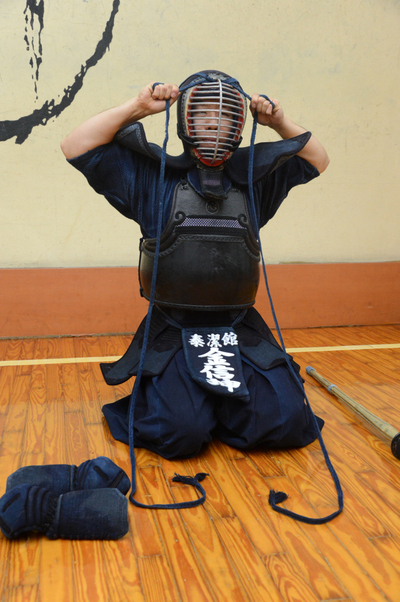
By: Chung Hee-cho/The Korea Herald - Current status:
Practiced
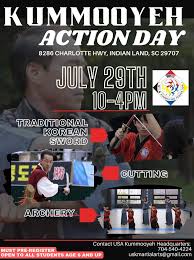
- Contacts:
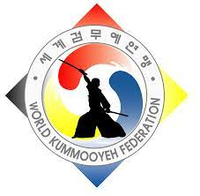
World Kummooyeh Federation
Web: https://kummooyeh.org/
World Kummooyeh Federation,
205, 100 Artcenter-daero 168beon-gil,
Yeonsu-gu, Incheon, South Korea 22006
Phone : +82 10 7551 1650
Email :This email address is being protected from spambots. You need JavaScript enabled to view it. ,This email address is being protected from spambots. You need JavaScript enabled to view it.
Fb: https://www.facebook.com/groups/302869703112650/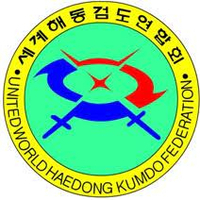
United World Headong Kumdo Federation
E-mail:This email address is being protected from spambots. You need JavaScript enabled to view it.
Web: http://www.haedongkumdo.co.kr/
Fb: https://www.facebook.com/jinyoungssangkum/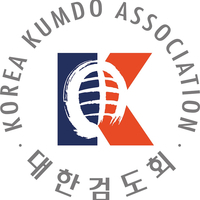
Korea Kumdo Association
Tel. 02-420-4258
Fax. 02-420-4350
Web: https://www.kumdo.org/
Youtube: https://www.youtube.com/channel/UClHvN16J4gBVj8i6p0lvhkQ/about - Sources of information :
Books:
Grand Master Edward Jacobsen, Haedong kumdo, volume 1, The ultimate guide to the korean sward martial art, Jacobsen - Randfontein, 2007Articles:
Scott Shaw, Just How Korean is Korea's Way of the Sword [in] Black Belt Magazine, May 2000
https://dojolifehq.com/kendo-vs-kumdo/?utm_content=cmp-true
https://kenjutsu-ryu.livejournal.com/20462.html
https://mas-swords.myshopify.com/blogs/articles/6-things-you-didnt-know-about-korean-kumdo?shpxid=094984ea-f133-4a07-b518-1aa978362474
https://www.swordsofnorthshire.com/blog/kumdo-vs-kendo-what-is-the-difference
https://www.kumdo4us.com/about-kumdoVideo:
https://www.youtube.com/watch?v=2mG4A7Sr1fU
https://www.youtube.com/watch?v=Z-MHsyXCB_g
https://www.youtube.com/watch?v=-0JVZu_-TSQ
https://www.youtube.com/watch?v=0WMRDnacDdQ
https://www.youtube.com/watch?v=LWIs6zw5lxM
https://www.youtube.com/watch?v=E3ai-IYKajw
https://www.udemy.com/course/kumdo-beginners/The information contained in the article comes from the following sources:
https://dojolifehq.com/kendo-vs-kumdo/?utm_content=cmp-true
https://kenjutsu-ryu.livejournal.com/20462.html
https://mas-swords.myshopify.com/blogs/articles/beginners-guide-to-kumodo?shpxid=d1fb9d27-a03c-4afb-88d6-bed5984c4b26Source of photos used in this article and gallery:
https://www.swordsofnorthshire.com/blog/kumdo-vs-kendo-what-is-the-difference
https://pl.pinterest.com/pin/281193570458162163/
https://m.koreaherald.com/view.php?ud=20131018000741
https://www.campus.sg/kumdo-korean-art-of-swordfighting-campus-sg/
https://mireumartialartsusa.com/kumdo-history/
https://northmnsword.wordpress.com/2018/02/18/welcome-to-kumdo/
http://www.kimstkdojang.com/kumdo-class-info/kumdo-what-is-it
https://www.groupon.com/deals/u-s-hwa-rang-kwan-kumdo
https://aprendecoreano.com/el-kumdo-o-hankumdo-de-corea/ - Gallery:
- Name of sport (game): Kurash
- Place of practice (continent, state, nation):
Uzbekistan
- History:
Kurash has long history. Many customs of Uzbek nation are incarnated in this sport. Scientific studies show that so initial type of sport, kurash was spread 3,5-5 thsouthand years ago. Many rare ancient findings found in Surkhan, Zarafshan and Fergana valleys, graphic art patterns drawn on rock-stones prove completely above mentioned opinions.
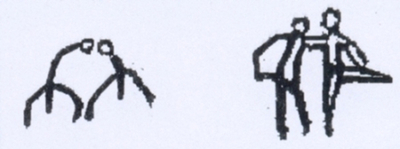
Picture 1. Rock carvings or petroglyphs found in the Tangri cave in the northern part of the Tien Shan mountain range featuring two Kurash players in action. Belongs to the Patriarchal period (more than 4 000 years B.C.). The picture from the IKA LibraryThere are several examples of Central Asian nations’ folklore, including “Alpomish”, “Gurugli”, “Avazkhon”, “Rustam”, “Tulganoy” epos in which brave, courageous, deft and dexterous, intelligent and wise people were aggrandized. Additionally, these heroes were respected as the symbols of the nation. In that fact, deeds of nation heroes in terms of boldness and couragenousness were honored and symbolized as a perfect person.
Some valuable findings was given in the works of great thinkers, for example “Kitob al konun fit tib” (Abu Ali ibn Sina), “Shohnoma” (Firdavsiy), Temur tuzuklari” (Amir Temur), “Hamsa” (Alisher Navoi), “Boburnoma” (Zahiriddin Muhammad Bobur), “Futuvatnomai Sultoniy” (Husain Voiz Koshfiy). Besides, there are honorable information in the epos of Uzbek and Tadjik folklores. We can know from these sources not only about kurash, but also its features, kurash conditions and measures.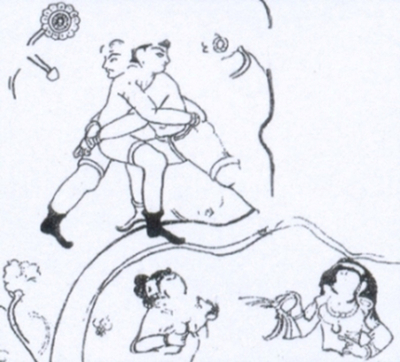
Picture 2. The wall-painting featuring two Kurash players from Sogdiana. Discovered in Samarkand, Uzbekistan. VII century A.D. The picture from the IKA LibraryKurash was reflected in folk-tales of Uzbek nation, too. For instance, we read the following sentences: “… seven years passed since then, Hasan and Zuhra grew up. Ones upon a time, Hasan played with children (fighted in kurash) and in that way he defeated all children of the country. As Hasan grew up, his strength also increased day by day. He began to defeat also older people in the homeland in fighting (kurash). Than Hasan became athletic and handsome person.
In “Tulganoy” tale, views of kurash were described. The army of Kukan Khan began to move Urta tepa. When Kukan Khan and the army of the Urta tepa were collided with each other, they did not start the battle, forces ranked in the lines. The heroes of Kukan and Urta tepa agreed with fighting in kurash. Then polvon Ollonazar started fighting. Ollonazar showed that kurash not only fighting or defeating opponents, but also kurash impacts soldiers spiritually and morally. Kurash contests’ have symbolic meanings, it reflects physical trainings, moral make-up fighting sides and helps to boost spiritual mood of the athletes. In “Hirs Polvon” epos, doing physical exercise has play a main role in shaping the qualities of strong man. One character of the tale says: “I have not met the strong person whose strength is equal to me. I do not want to be defeated by opponents. Therefore, I do exercise or do kurash regularly”. They show about exercises that are effective in system of physical education. For example, using the kurash technique of “Qoqma” by Hirs Polvon was given in this tale. It is noticeable that “Qoqma” technique is still used in today’s kurash.
The epos of “Alpomish” has a role in the folklore of Uzbek nation. The fictional ideas of these epos has vital basis, and it units with real historical events. Struggles of kurash athletes, their strength, dexterity, tolerance and knowing or using them in kurash were described in a fictional way in “Alpomish”. Material evidence found due to the investigations, explorations scientific archeological searchings and observations of historic, ethnographic and philosophic scientists gives crucial facts about kurash. Known as an initial individual sport type, kurash appeared in the area of Movorounnahr.
It was common ritual for people who lived in that time to hold kurash competitions in the weddings, festivals or national holidays and brave, bold men used to be applauded proudly.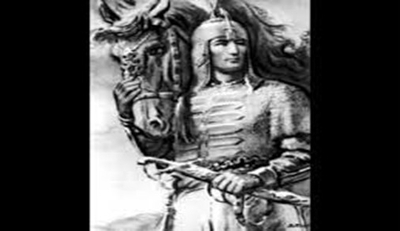
Picture 3. The picture of AlpomishAncient manuscripts belong to BC show that kurash had a main in general performances and national spectacles. Many written and historical monuments proud abovementioned information. For example, Elian Klavdiy, antique scientist, pointed that in the past, Sak and Massagets tribes lived in the area, correspond today’s Uzbekistan territory. Kurash was widely spread among these tribes. It was usual when men were going to get married, they had to defeat their fiancées in kurash competitions. This tradition depicts even women trained kurash in that time.
A famous orientalist and ethnographer S.P.Tolstov wrote that kurash was a great importance in the history of Uzbek nation, in Eid Ramazan or Kurban Hait ceremonies, in the days of Navruz holiday. Under the leadership of eldery people, kurash competitions were held in the first three days of these holidays, people came to watch, prisoners were released, guiltes were forgiven. In fact kurash played a vital role in the lives and lifestyles of Uzbek nation.
In the period of attacks to Central Asia by Aleksandr Makedonski, social life, economy, lifestyle of people developed well. Moreover, different games and sports, physical training and athletic games were organized in Central Asia as Ancient Olympic Games in Greece. In the period of Sogdiana and Baktria’s forces, adroit and skilled acrobats were popular among people lived in Central Asia in BC. Adroit, battle-hardened door-keepers in physical respect went to Greece, Iran and Vizanty in order to praise about their amazing and at the same time extreme games, circus performances that were filled with pointed satire and laughter, active, flexible and unbelievable games of athletes, seething dances of hukkachi and wooden feet or horse dances, deep meaningly words and jokes of clowns.
In old times, community had a member of obligations and responsibilities in terms of physical training field. Young generation would have to have several qualities needed in real life, including braveness, adroitness, tolerance and definiteness. Famous Grecian historian Kwint Kurtsiy Ruf wrote that the army of Aleksandr Makedonski captive 30 strong athletes during conquering Central Asian’s areas. It was clear to kill captives. Knowing their sorrowful fate, they kept themselves brave, began to sing songs, danced with one another. Because, of their such actions, the captives were appraised highly by Aleksandr Makedonski and he decided to save their lives. Though many years or centuries passed since then, historical folktales and legends still do not lose their importance.
Arabs invaded Middle Asia (VII-VIII centuries), continued to move nearer to Samarkand city, but they were not able to enter there. Then, Arabs made a hole through the wall of the city. The way for city was opened. However, on the hole of the wall a strong man appeared suddenly and blocked the hole which caused them not to conquer the city in a long time, further, the killed many of the enemies with his sward. At that time Arabian Khalifa Kutayba announced to donate 1000 dirham for the person who bring that strong man’s head. Afterwards, enemies pounced crowdedly and strong man perished in this incomparable battle. Unfortunately, the name of that hero was unknown in history. Despite this, his heroic deeds were preserved among nations and he is still known for today’s people.
We can know about the kurash history from the literatures of past life. For example, in “Shohnoma” epos of Abulkhasim Firdavsiy, nation honour strong, brave men grew and challenge them to from enemies. Furthermore, kurash was a main importance in the epos of “Gulistan”, Sadiy Sheroziy. The author wrote about a person who aware of how to fight and knew 360 kurash techniques, therefore he used different techniques of fighting in each days. He thought 359 throwing techniques of struggling to his one follower. However, he kept the secret one of his technique from his follower. The student regarded that he knew all tricks and nobody showed resistance to him.
And so, there were lot of types of wrestling in nation. There were even teachers (coaches) teach these wrestling types to young generation, however, the description of these wrestling types are not known for us. For example, Mahmud Koshgariy, historic and linguist, wrote his book (“Turk og’zaki va yozma ijodiyoti to’plami”). This book gives us crucial facts about different types of wrestling. He pointed about kurash belt, uniform and athletes’ physical capacities. He wrote that athletes must be strong, flexible and elastic. He listed some ancient strong athletes (polvons).
Academic A.Askarov says by presenting some interesting information about ancient kurash athletes: “Famous kurash athletes had a special sign on their wrists who come to the gilam12 to fight. If the athlete were women, the sign would be in the neck of them. This tradition was seen in the source of ancient Kirgizs, too. Signed boys and girls were considered the most powerful, strongest and famous among the kurash athletes. In daily life they would cover their sign under the dress and other people did notice the sign. When they come to the field (gilam), their sign were visible to opponents and it made them hesitate. Many spectators applauded more signed athletes”.
Uzbek people consider that kurash is a means of the upbringing of person. Actually, kurash athlete who had strong, endurance, became strong-willed and brave or incarnated moral pureness of hard-working people were deeply-respected. According to the historical rules struggle time were not limited and athletes were chose their contestants with their appearance. Before the fight they used to do light exercises or massages their body. The kurash uniform was traditional.
As we pointed before, there were different types of wrestling in ancient territory of Uzbekistan. According to the rules of “Fergana” style, kurash athletes wore cotton clothes namely “chopon”, while they athletes from “Bukhara” style used to wear oriental robe without cotton in competition. In addition, they were required to wear traditional trousers namely “ishton” and special shoes. Usually, kurash athletes fight without shoes. This traditions wearing exists in today’s kurash, also. It is started in ethnographic investigations that kurash was early development in the area of Uzbekistan and it was common for people to organize kurash matches in weddings or general community performances.
Ancient sources or manuscripts give irrefutable evidence about kurash athletes. Many fighters (polvons) were world-famed in terms of trying one’s strength, raising heavy things, and outstanding heroism, therefore they became well-known among nation and countries, finally named “polvon”.
It was written that many kurash competitions were held in the areas of Uzbekistan X century AD. It was noted in ancient Chinese manuscript that the people of Fergana organized competitions by being divided in two groups on Navruz holidays. Other fact is that, according to the information of Maksudiy, Arabian geographer and traveller, belong to X century, that there were also similar customs to hold kurash struggles in the big cities, coupled with Marv, Samarkand and Balh. Indeed, people gathered in one place in accordance with their wishes and willingness and arranged such competitions on Navruz holidays.
There were different types of the wrestling in ancient borders of Uzbekistan territory, some types were embodied in it and became famous under the name of kurash. These types were differentiated from one another according to the rules or usages in practice, and their fighters wore special uniform “yaktag”, “chopon” or belts on wrists. Definitely, the action of kurash were done by holding somebody by the belt.
Fighting two men pictured in the thin border b order of silver ladle that belongs to the middle of the first thousands years ago. Scientists confirm that this silver ladle appertains to ancient Vizanty. Also, several items that found Chelak village near Samarkand gives valuable information. Among geometrical patterned carvings, silver handled package is the most attractive. On the handle of its, two fighters were fighting in kurash. This finding belongs to first middle ages which means that kurash has a long history.
Some opinions about kurash and physical training were reflected in the points of Ibn Sina. Ibn Sina was able to give correct instructions to the fighters in the field of utilizing methods of physical training. The amount of physical training and defining it was seriously paid attention by this famous philosopher. Furthermore, he equally illustrated the organs of physical training according to the condition of it. When organs would be temperate, the temperate body would be suitable for it. If it is necessary to make weak bodies strong, these organs should do exercises a lot. The strong and through points, knowledge of Ibn Sina about physical training have been successful for coaches.
Pahlavon Mahmud has huge significance when it is talked about the development or history of kurash. Although he was a fur-tailor, Pahlavon Mahmud was a good in kurash and never failed. In fact, he was a great philosopher and poet lived between XIII and XIV centuries. He was born in 1248 year near Khiva (Khorazm) while his family was moving from Urganch to Khiva. Pahlavon Mahmud grew up physically powerful and he trained with kurash. He fought in a lot of kurash competitions and became winner held in the cities of Khorazm together with India. Therefore, Mahmud was well-known with the name of “Pahlavon”.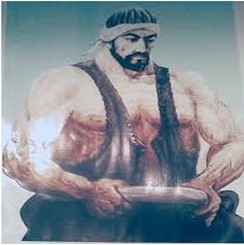
Picture 4. Photo of Phakhlavon MakhmudAccording to stories, Pahlavon Mahmud saved the live of Roy Ropoy Chuna, the king of the India, in one of the wars. Then, in return for this, he made captives who were Khorazm release from India. An ardent patriot built a number of gravestones for the warriors, died in the war happened near Khiva against the army of Chingizkhan.
Because of being physically strong, many cowards were afraid of him. However, Pahlavon Mahmud was naturally modest fellow.
We can’t imagine kurash without the Great Amir Temur! During the period of great Amir Temur and his powerful dynasty culture, science, art, cottage craft and military fields were hugely developed. Especially, Amir Temur put a lot of emphases on making progress of military.
According to the historical evidences, he had no equal in terms of kurash, measuring strength or swords, shooting an arrow, and riding horse. Kurash was an inseparable part of Amir Temurs soldiers and their exercises. On the grounds of the Marcel Brion, French poet and historian, Amir Temur was incomparable in kurash and he was courageous, had a character of appreciating bold warriors. Even, there were such situations at wars that soldiers had to fight against enemies without weapons individually. Also, Temur made some important notes about kurash in his autobiography.
Being overthrown of the kingdom of Amir Temur led to cease exist experience and achievements. After that, it was pointed at historical sources or manuscripts that Bobur trained with kurash and he thought the secrets of fighting to his warriors. As a result of leaving for India and reigning there, kurash began to be spread over India and developed.
According to written notes by Gulbadanbegim, the daughter of Bobur, women wore dresses that suitable for triumphal days and they attended actively in riding horses. Also, Gulbadanbegim wrote about women’s name who sat in beside of kings in triumphs and their abilities in diverse craftmanship and skills or capabilities in playing different musical instruments. - Importance (for practitioners, communities etc.):
THE PHILOSOPHY OF KURASH
It’s true that kurash has great importance in upbringing healthy generation. In every respect, strengthen defensive might of the country and improving military service. Obviously, kurash is the most valuable that plays a vital role in shaping unanimous nation. Not only kurash is the skills of fighting physically with opponents, but also bring up youth in the spirit of humanity and culture. Kurash is incarnated with the following ideas that this sport teaches to admit bravery, honesty and integrity, victory and failure and to respect the opponents, coaches, spectators and referees. In this chapter of this guide, the book will say about philosophy and social importance of kurash.
Kurash helps to upbringing every young people in spirit of being patriotic to his or her Motherland and loyal to the country. How the kurash athletes are patriotic, or how much they have loyalty and honesty, their spirits in the kindness to their Fatherland to will be clarified in the process of doing exercises, preparing for crucial competitions, esteeming themselves during the results of the games.
Athletes who are never be defeated are presenting this perfectly and showing examples by this how they are in patriotic and humanity spirit. In reality, kurash is considered as a means of upbringing young people in physically hardening.
Of course, firstly, kurash was valuable custom of Uzbek nation, which caused to develop completely, secondly, kurash has a vital role in shaping young generations to be spiritually perfect. Since the tendency and ideas are fair, it rises the feelings of person to higher degree. Indeed, kurash is connected with the life of Uzbek nation spiritually as being existed in heredity of Uzbek people.
As we know that in the worldwide all countries are putting emphases on raising youth healthy and intellectually skillful in every respect. In the system of Education, Healthcare, Sport and other different spheres in society are becoming wanted consequences in both enhancing and developing education system. The necessity of working out efficient organizational-pedagogical factors based on national and global traditions and customs is widely illustrated in some special programs. In return for these chances together with kindness and attention, young people should have a duty to achieve higher results by showing their real abilities in international tournaments and Olympiads.
The role of the types of national sports, especially kurash is huge in terms of bringing up spiritually-perfect and creatively-intellectual generation.
The long history of kurash was glorified as sample for perfection of athletes. A physical strength, adroitness aspects, behaving modestly among people, conducts, spiritual appearance, the attitudes towards opponents, referees, carpets and spectators together with other characters of kurash athletes have a special significance.
A lot of legends were created about kurash athletes in ancient times. Being athlete in nation is cultural and great heritage. This custom and heritage is still deeply-esteemed and will respected in the future, also. In today’s world, lot of countries are paying attention to respect athletes and appreciating them in a wide respect.
The philosophy of kurash is, today hugely comprehensive. It corresponds with the cultural aspects of physical training. In this field, some scientists have carried out different investigations (for example, Uzbekistan, India, Turkey and others). In particular, they gathered a great deal information about learning scientific, philosophical, social and cultural knowledge of kurash. Several scientists such U.Ibrokhimov (died) and J.Toshpulatov (Uzbekistan, Surkhandarya), A.Atoev (Uzbekistan, Bukhara), F.Akhmedov (Uzbekistan, Jizakh) gave crucial information about philosophical and pedagogical aspects of sport, especially, kurash in their researches.
Divers views and opinions about kurash were notified in international and national meetings and conferences. The works of academic F.Tulenov, professors M.Murodov, U.Koraboev, I.Jabborov, T.Javliev, Kh.Homidov, O.Musurmonova, M.Davletshin, F.Nasriddinov, T.Usmonkhujaev and R.Abdumalikov are absolutely essential.
Organizing the development not only among young generation but also elderly people is leading to be formed healthy lifestyle. Kurash is being developed step by step between youth since it is unseparable part of the culture and life.
People confess that the role of kurash in upbringing of the person is pedagogically high. In order to prove abovementioned opinions and views, clarifying the conditions of kurash is suitable. Firstly, making a bow (tazim) before the contest for each other is a symbol to show the most honorable virtues of humanity. Opponents bow each other means that they are opponent only over the “gilam”. These actions are embodied with the strong respect towards one another.THE SPIRITUAL, CULTURAL AND MORAL IMPACTS OF KURASH
Kurash means fighting, discussing and arguing. Kurash contains actions and conditions which include special physical exercises. Together with this, a special character of kurash is hugely important in growing up of the person. The development of the society leads to improvement of the culture. In today’s life, kurash has a huge significance in society.
In recent years, investigations directed to learn the aspects of sport and its role has been in high degree in the lifestyles of people. Over this issue, the specialists of physical training and sport, psychologist have carried out studies and achieved different scientific, methodological and theoretical resources in diverse degrees (V.D.Panachaev, N.I.Ponomarev, L.P.Matveev, Y.Masharipov, R.S.Salamov, L.I.Lubisheva).
Towards athletes who won in competitions and tournaments “athlete”, “winner” and “champion” words were widely used to describe them. Most people were envious of these fighters, as a consequence, great enthusiasm appeared in ordinary people to participate in kurash competitions. Usually, people have a tendency to appreciate kurash as a symbol of winners and champions.
It is clear that sport has some special and general functions. According to the theory of sports there some tasks in sport, a competition task, a healthy task, an idea task, an ethic task, an educational and moral task, a social task, a social and political task, an international task. As well as, it is noted in certain resources that sport plays a major role in bringing up patriotically. Sport is just not to define the results, or to show abilities of physical opportunities, but also it is connected with human upbringing and it is a human factor. Being received as an international sport and being improved over the respect years, kurash has been regarded as a suitable for general standards.
As it pointed in the law of the Republic of Uzbekistan “About Physical training and sport” National types of sport and national games are indivisible part of physical training and sport in the field of cultural heritage of the Republic of Uzbekistan, further sport paves the way for upbringing the youth in spirit of attempting to spread the reputation of the country. It is real that national sport types, social development and shaping them are interconnected with bringing up young generation in a patriotism mood. For example, kurash contains respecting opponents, defending self-esteem on the base of philosophical and moral opinions. The ideas of patriotism, humanism, peace and peace-loving and making nation industrious are incarnated in a historical development and formation of kurash. For, peace, patriotism, humanism, industrious have been appreciated and honored as a national value.
As kurash is a humanitarian value, it is reflected in character of humanism. Simply, it can be seen that kurash is just type of sport after particular preparation of athletes or attempts to defeat one another in competitions. However, the rule of competitions and general standards of kurash have such requirements for kurash athletes, referees, coaches and other participants that in competition process will be formed and brought up in accordance with sport programs and values of humanity. It is vitally essential to hold sport competitions, physical trainings without any damages to the health of spectators and participants. It is prohibited to use dangerous methods to prepare that might cause injuries or humiliation of sportsmen’s honor and virtues.
The rule of kurash competitions are worked out in special way that athletes must obey the rules. At the same time, kurash respects its high humanism character.
In the world, keeping the health of people is satisfying condition and improving it perfectly is a basic duty of medicine. There is a notion in the medicine world that “Instead of treating disease, it is more preferable to prevent it”. In contemporary life, where technology has been advanced, being passive (because, many things are done by technology) brings are about several issues, especially disease, including obesity. Doing exercises regularly on the bases of schedule provides the organism of the body with necessity to be active. Then, wanted consequence, including healthy organism and strong body can be achieved. This is one of the important reason why kurash is deeply valued as humanism.
Today’s global circumstance is resulting in different negative issues, coupled with terrorism, religious extremism and illegal drug trafficking. These problems hardly fail to affect the life of people, society and country. Modern kurash is trying to bring up every kurash athlete or participant in accordance the goal, not just to get higher results from training or competitions.
Modern Olympic Games’ propagandist prominent French statesman Pierre de Coubertin organized Olympic Games which was a great importance for humanity and it was received as a means of educating and upbringing. After a second Cold World War, organizing Asian Games owing to enterprising of India was about enhancing welfare programs, keeping the peace and unanimity among the nations. Therefore, people should have a duty to develop kurash and value it as humanism character.
In order to propagate this propaganda, it is crucial to make kurash more common among people. Especially, arranging to show scientific-methodological bases of kurash, and organizing investigations about the theory of kurash and its methodology. Briefly, the knowledge of kurash should be developed. The created land written literature of kurash has made great contribution to the development of kurash. However, to reach fast-term development in the field of sport requires to add kurash in Olympic Games and creating more successful literatures about kurash and investigations. It can be said proudly that there are any opportunities to enhance and improve science, education, sport and other fields.
Carrying out different studies and organizing investigations are becoming a major factor and they are a huge crucial task for coaches, referees, scientists and specialists in these days. Since, the world should know that kurash is the oldest type of wrestling and under the meaning of kurash, there are honesty, bravery and patriotism that are the most valuable virtues for people. - Sources of information :
Source of information: Farruh Ahmedov, International Kurash Institute, KURASH: HISTORY AND SOCIAL SIGNIFICANCE
- Name of sport (game): Kyun - Rakhine (Arakan) wrestling
- Place of practice (continent, state, nation):
Myanmar, (Arakan) Rakhine
- History:
A traditional sport, Kyun, is very popular for Rakhine people in Myanmar. This sport began from the reign of former Rakhine kings in history. Figure of Kyun sport can be seen on the walls around the cave of Shaitthaung Temple built by King Mong Bar Gri reigned in Mrauk-U in A.D 1531.
- Description:
Kyun - It derives from Kyar–Yun. Kyar” means “tiger” and “yun” means “quick”. Therefore, the complete meaning of “Kyun” is the quick tiger. The Rakhine wrestler can be called as a quick tiger because of his ability in wrestling movements and techniques.
In this competition, there are two steps. A new one can compete only in the step of silver gong (Nge-maung-dan) and a successful and well-experienced one can continue to compete in the step of golden gong (Shwe-maung-dan). Famous Rakhine wrestlers are Nyalar U Tun San Phyu, U Lun Hla Oo (Nyalar U Tun San Phyu's elder son), U Kyaw Min (Nyalar U Tun San Phyu's younger son), U Shwe Aung, U Maung Phyu Thee and U Maung Ni widely known in Myanmar.
There are 28 ways of Kyun wrestling and its 23 rules to follow. In Kyun wrestling, of two rivals, one is catcher and the other is defender Kyun wrestlers gird their loins wear a white belt and a black belt each. Their upper bodies have no clothes and are barefoot. This competition is done in the smooth and wide fields.
While competing, the catcher wrestler has to try to control the other three times. If he does not win even in the third chance, the defender becomes the catcher again. They use the ways of grappling, grasping, kicking, (leg)-putting, (leg) hooking and (leg) twisting in trying to make the rival fall down and win. There are two Kyun referees to watch carefully and make a decision whether two wrestlers use the right and systematic wrestling methods or not. The two referees' active movement is called Kyarlar.
Rakhine traditional Kyun wrestling was held in royal occasions in the reign of former Rakhine kings. Today, it is accompanied with pagoda festival, hoisting Hti (umbrella), funeral, Thingyan water festival and boat racing. If there are many competitors in Kyun wrestling, it takes for three days to select the winner. The last day of final match is for silver gong match and golden gong match. The winner or the loser can be awarded from the audience. The prize golden gong or silver gong is quite purely made of gold or silver and weighs one or two hundredth of a viss.
In the former days, precious diamond gong used to be in the central part of the golden gong. A famous Kyun wrestler's pleasant mind in his success makes him strong and confident for his future life. - Current status:
Practiced. The “Kyun” wrestling is usually performed at the pagoda festivals.
- Importance (for practitioners, communities etc.):
Rakhine people have a long tradition of holding wrestling competitions during the annual festivals in their towns and villages. It is one of the Rakhine traditional sports which mainly based on physical ability to uplift the happiness and physical prowess. It’s a kind of martial art. The skill of wrestling and making one’s rival fall on to the ground while avoiding hid attack is called “Kyun”.
Kyun sport, Rakhine wrestling, is a physical art for men Rakhine men are trained this art starting from childhood. The strong man who can wrestle well is regarded and honoured as "Kyun than" in Rakhine. Rakhine kyun sport is similar to wrestler in some way but it is quite different in rules and methods. A famous and outstanding Kyunthan had many difficulties to face and win rivals and matches. - Sources of information :
Books:
Aung, Myar. Famous Monuments of Mrauk-U, (2nd ed.). Yangon, Myanmar. Middle Line.
Video:
https://arakan-reality.smugmug.com/ARAKAN-Life-Culture-VIDEO/i-BFwPr2k
https://www.youtube.com/watch?v=dnweTRJLy0w
https://www.youtube.com/watch?v=1ISukAgnZv4The information contained in the article comes from the following sources:
https://arakanindobhasaa.blogspot.com/2015/07/rakhhine-traditional-martial-art-of.html
https://www.linkedin.com/pulse/rakhine-arakan-traditional-sports-tun-soe-naing/
http://arakanesehistoryandculturecenter.blogspot.com/2013/06/arakan-culture-sports.htmlSource of photos used in this article and gallery:
https://arakanindobhasaa.blogspot.com/2015/07/rakhhine-traditional-martial-art-of.html
https://www.gnlm.com.mm/rakhine-traditional-wrestling-contest-marks-47th-rakhine-state-day/
https://kbr.id/indonesia/02-2013/kyun_ala_burma_untuk_sea_games/6.html
http://arakanesehistoryandculturecenter.blogspot.com/2013/06/arakan-culture-sports.html - Gallery:
- Name of sport (game): Lagori
- Place of practice (continent, state, nation):
India
- Description:
Lagori, dikori or lagoori, also known as Lingocha, Pithu (Punjabi), Palli Patti (Karimnagar), Pitto (Rajasthan), Pittu (Bengal) or Satoliya(Madhya Pradesh).
Lagori is a team sport that originated in Southern part of India. The sport is played only at a recreational level, a popular playground game. The sport goes buy many names, including Pittu Garam (meaning 7 stones).
Lagori is played between two teams, with a minimum of 3 players and a maximum of nine on each team, using seven stones and a rubber ball. Each team gets nine chances, 3 players taking 3 chances each, to knock down the stones that are stacked vertically, from a distance of about 20ft. If one team is unable to knock down the stones the next team gets the chance to throw.
If the throwing team knocks down the stones, the objective of the team is to stack all the seven stones back. The objective of the defensive team is to strike any player of the throwing team with the ball, below knee level. Players on the defensive team are not allowed to run with the ball and have to pass between players to move the ball.
If the offensive team successfully stacks the stones first, the team receives a point, and gets to throw the ball again. If the defensive team is able to strike a player first below the knee, there is a change in possession.
There are no fixed rules for number of players or match durations. Matches are usually played for a fixed number of points, about 7 to 10. - Current status:
Practiced
- Sources of information :
- Name of sport (game): Lethwei
- Name in native language: Burmese: လက်ဝှေ့
- Place of practice (continent, state, nation):
Myanmar
- Sources of information :
Books:
Zoran Rebac, Traditional Burmese boxing, Ed. Paladin Press, Boulder, 2003Articles:
https://www.thefight-site.com/home/introduction-to-lethwei-1

